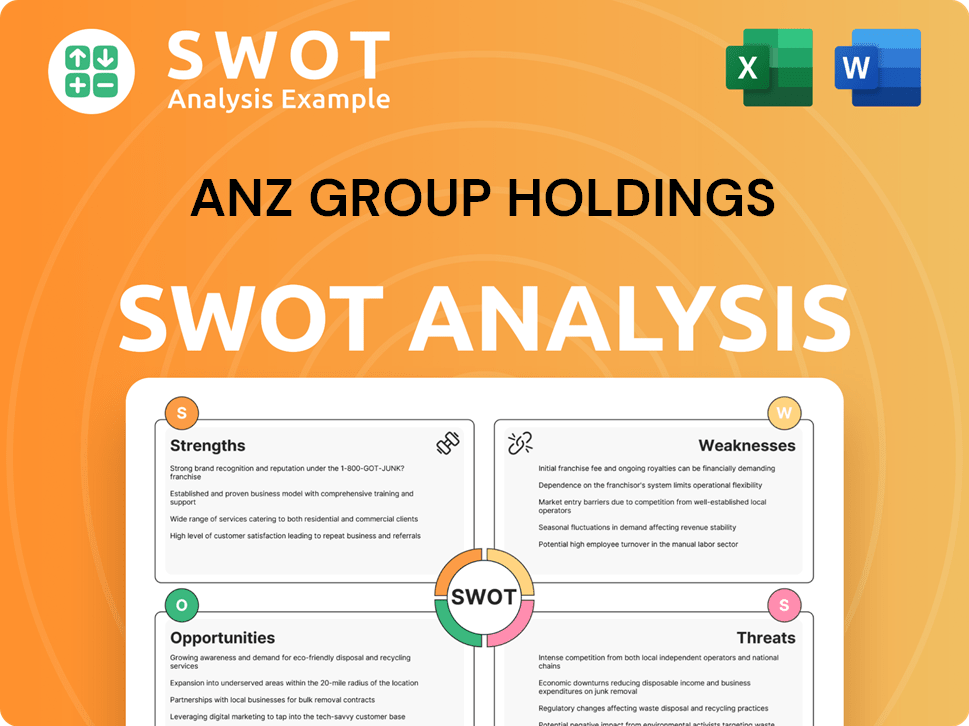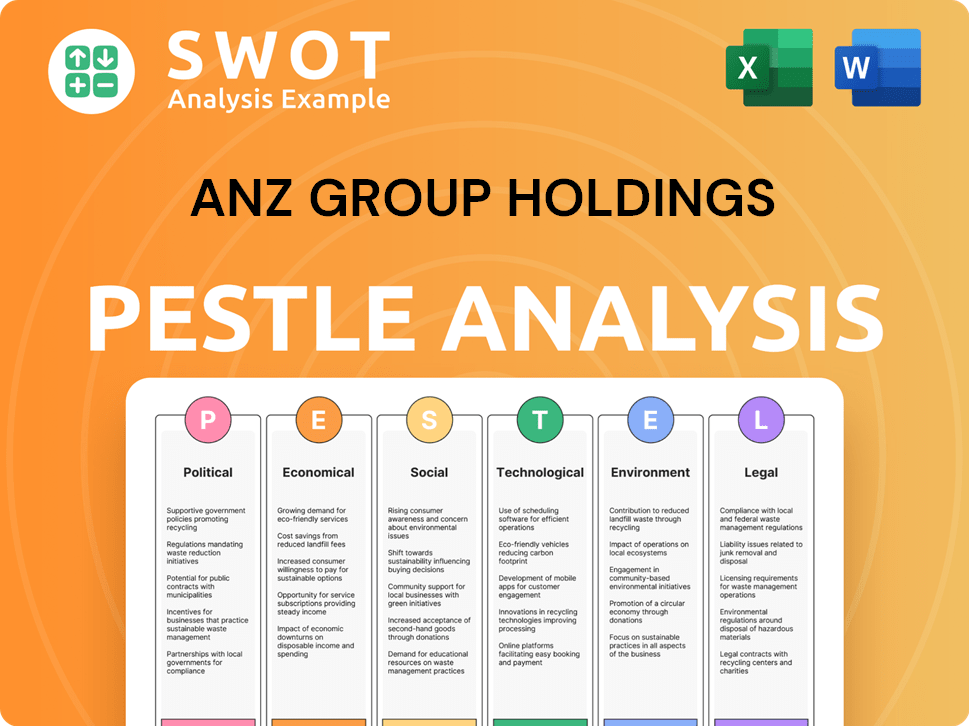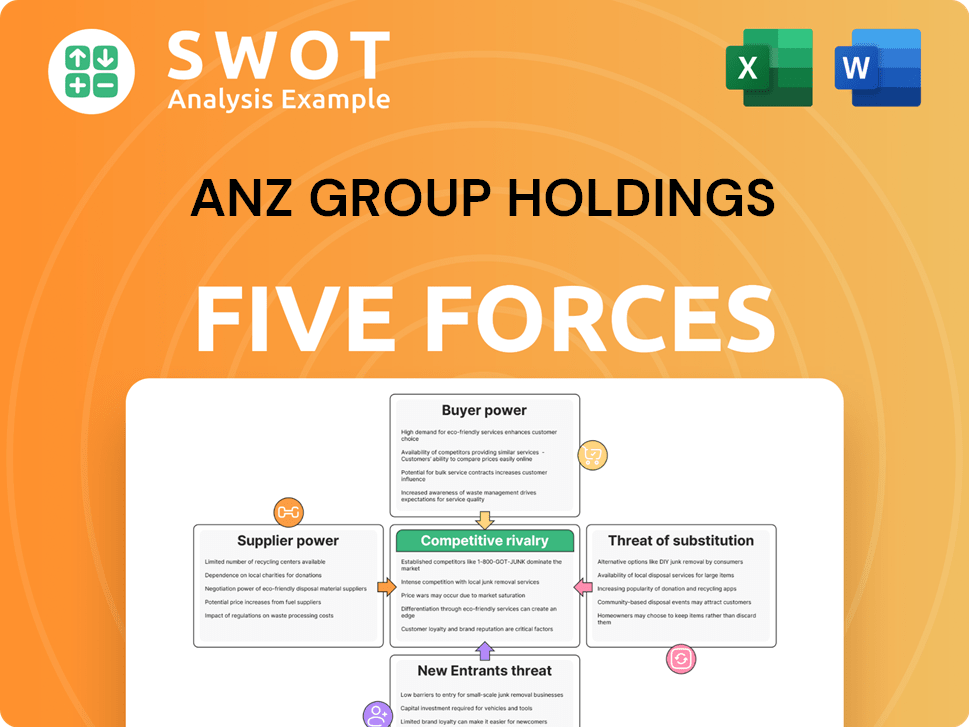ANZ Group Holdings Bundle
How Does ANZ Group Holdings Dominate the Banking Sector?
ANZ Group Holdings, a financial powerhouse with roots stretching back to 1835, has strategically navigated the evolving financial landscape. From its humble beginnings to its current status as one of Australia's 'Big Four' banks, ANZ has consistently adapted its sales and marketing strategies to stay ahead. This analysis dives deep into the tactics that have fueled ANZ's growth and solidified its position in the market.

This exploration of ANZ Group Holdings SWOT Analysis will uncover the core elements of ANZ's sales strategy and marketing strategy, from its digital transformation initiatives to its customer-centric approach. We'll dissect how ANZ leverages its brand positioning and innovative marketing campaigns to capture and retain customers within the competitive ANZ market. Understanding the ANZ business model and its commitment to ESG practices will provide valuable insights into its long-term sustainability and success in the ANZ financial services sector.
How Does ANZ Group Holdings Reach Its Customers?
The sales strategy of ANZ Group Holdings is multifaceted, utilizing a blend of traditional and digital channels to reach its diverse customer base. This approach reflects a strategic adaptation to evolving customer preferences and technological advancements. The company's focus on omnichannel integration and digital transformation is evident in its substantial investments in digital platforms and services.
ANZ's marketing strategy is designed to enhance customer engagement and improve financial well-being through platforms like ANZ Plus. The company’s commitment to digital innovation is underscored by its significant annual ICT spending, estimated at $2.5 billion in 2024. This investment supports the development of online services, including insurance and loans, thereby catering to a broad spectrum of financial needs.
The acquisition of Suncorp Bank in 2024 is a key move that strengthens ANZ's retail banking footprint. This integration is aimed at creating a seamless omnichannel experience for customers. Furthermore, ANZ leverages strategic partnerships, particularly in Asia, to support trade and capital flows, positioning itself as a key banking partner in various Asian markets.
Historically, physical branches and direct sales teams have been crucial for ANZ's go-to-market strategy, offering personalized service. These locations provide essential touchpoints, especially for complex financial products. This network supports relationship-based banking and caters to retail, commercial, and institutional clients.
ANZ has made substantial investments in its digital platforms, including its website and mobile apps. These platforms offer a wide array of online services, such as insurance and loans, enhancing customer convenience. Platforms like ANZ Plus are central to deepening customer engagement and improving financial well-being.
ANZ is increasingly focusing on direct-to-consumer digital offerings to meet evolving customer demands. This shift complements its physical presence, which remains important for complex financial needs. The DTC strategy aims to provide accessible and convenient financial solutions.
ANZ leverages key partnerships to expand its reach and service offerings. In Asia, partnerships support trade and capital flows, positioning ANZ as a key banking partner. These collaborations enhance ANZ's market presence and provide access to new customer segments.
ANZ's sales channels are evolving to meet changing customer expectations and leverage digital opportunities. The company is allocating a significant portion of its $2.5 billion ICT budget towards software, hardware, and services. This investment is crucial for supporting the Competitors Landscape of ANZ Group Holdings and driving growth.
- Physical Branches: Continue to provide personalized service and handle complex financial products.
- Digital Platforms: Offer a comprehensive range of online services, enhancing customer convenience.
- Direct-to-Consumer (DTC) Offerings: Focus on accessible and convenient digital solutions.
- Strategic Partnerships: Expand market reach and support trade and capital flows, especially in Asia.
ANZ Group Holdings SWOT Analysis
- Complete SWOT Breakdown
- Fully Customizable
- Editable in Excel & Word
- Professional Formatting
- Investor-Ready Format

What Marketing Tactics Does ANZ Group Holdings Use?
The marketing tactics employed by ANZ Group Holdings (ANZ) are designed to build brand awareness, generate leads, and drive sales. Their approach is multifaceted, integrating both digital and traditional strategies. Digital marketing is a cornerstone, with a strong emphasis on content marketing, SEO, paid advertising, email marketing, and social media platforms.
ANZ leverages various social media channels, including Instagram, Facebook, LinkedIn, and Twitter, for marketing and communications. These platforms are often used to highlight arts, sports, sustainability, and societal events, rather than solely focusing on advertising campaigns. Data-driven marketing, customer segmentation, and personalization are integral to ANZ's strategy, enabling them to reach specific customer groups effectively.
ANZ's estimated annual ICT spending in 2024 was approximately $2.5 billion, with a focus on artificial intelligence, cloud-based applications, and big data. This investment indicates a strong foundation for data-driven marketing and personalization efforts. The company's SEO strategies are robust, with a significant portion of its web traffic, around 2.3 million visitors, originating from organic searches, supplemented by paid marketing activities.
ANZ's digital marketing strategy emphasizes content marketing, SEO, paid advertising, email marketing, and social media engagement. This approach helps in brand awareness and lead generation within the ANZ market.
ANZ maintains a presence on platforms like Instagram, Facebook, LinkedIn, and Twitter. These channels are used for marketing and communications, often featuring content related to arts, sports, and sustainability.
SEO is a key component of ANZ's marketing. A substantial amount of web traffic, roughly 2.3 million visitors, comes from organic searches. This is supported by paid marketing activities.
ANZ utilizes data-driven marketing, customer segmentation, and personalization to reach specific customer groups efficiently. This approach allows for tailored marketing messages and product offerings.
ANZ's significant investment in ICT, with an estimated $2.5 billion spent in 2024, supports data-driven marketing. This investment includes AI, cloud applications, and big data initiatives.
ANZ has launched innovative campaigns like 'Simpler Home Loans' and 'The Only GAYTM in the village' to highlight product simplicity and social inclusivity. The ANZ Plus campaigns, launched in March 2025, focus on financial confidence for younger Australians.
ANZ's marketing mix has evolved to prioritize digital engagement and customer financial wellbeing. Noteworthy campaigns include 'Simpler Home Loans,' which used fashion-style advertising to emphasize the straightforwardness of home loan options. Another campaign, 'The Only GAYTM in the village,' transformed ATMs into artworks to honor the LGBTI community, demonstrating ANZ's commitment to social inclusivity. The ANZ Plus campaigns, launched nationally in March 2025, focus on instilling money confidence in younger Australians through various channels including social, digital, out-of-home, and online video. For more insights into their target market, you can read about the Target Market of ANZ Group Holdings.
ANZ's marketing strategy combines digital and traditional tactics, with a strong emphasis on data-driven approaches and innovative campaigns. These tactics are designed to enhance the company's sales strategy and brand positioning within the ANZ financial services market.
- Digital Marketing: Content marketing, SEO, paid advertising, email marketing, and social media.
- Social Media Engagement: Active presence on Instagram, Facebook, LinkedIn, and Twitter.
- Data-Driven Marketing: Customer segmentation and personalization.
- Innovative Campaigns: 'Simpler Home Loans,' 'The Only GAYTM in the village,' and ANZ Plus.
- ICT Investment: Significant spending on AI, cloud applications, and big data.
ANZ Group Holdings PESTLE Analysis
- Covers All 6 PESTLE Categories
- No Research Needed – Save Hours of Work
- Built by Experts, Trusted by Consultants
- Instant Download, Ready to Use
- 100% Editable, Fully Customizable

How Is ANZ Group Holdings Positioned in the Market?
ANZ Group Holdings strategically positions its brand to stand out in the competitive financial services sector. The core of ANZ's brand is its purpose: 'to shape a world where people and communities thrive'. This purpose guides its core message, focusing on financial wellbeing and sustainability for its customers. The brand aims to be a trusted partner, helping customers adapt and become more resilient to economic changes, including assisting large business clients in their transition to net-zero.
The company differentiates itself through a combination of comprehensive service offerings, a strong regional presence, and a growing commitment to sustainability. As one of Australia's 'Big Four' banks and the largest in New Zealand, ANZ provides a wide array of retail, commercial, and institutional banking services. Its broad geographic footprint and connections across Asia's key trade routes offer a unique advantage compared to more domestically focused competitors. The company's visual identity and tone of voice generally convey stability, reliability, and a forward-looking approach.
ANZ's brand resonates with its target audience through its dedication to sustainability and social responsibility. ANZ has set a goal to fund and facilitate at least $100 billion by September 30, 2030, in social and environmental activities through customer transactions and direct investments. This commitment is a significant unique selling proposition, aligning its business strategy with global sustainability goals and appealing to ESG-focused investors. In 2024, ANZ also announced it would cease funding new or expanded oil and gas extraction projects, further solidifying its sustainability stance. For a deeper understanding of the company, you can explore the Brief History of ANZ Group Holdings.
ANZ's sales strategy focuses on providing comprehensive financial solutions to a diverse customer base. This includes offering a wide range of banking services, from retail to institutional, to meet varied financial needs. The strategy emphasizes building strong customer relationships and leveraging its extensive regional presence to capture market share.
The marketing strategy of ANZ centers on reinforcing its brand purpose and values, particularly financial wellbeing and sustainability. Campaigns highlight ANZ's commitment to ESG (Environmental, Social, and Governance) factors, appealing to a growing segment of investors. Digital channels and targeted messaging are used to engage with customers effectively.
ANZ's business strategy involves a multi-faceted approach, encompassing retail banking, commercial banking, and institutional banking services. The company also focuses on expanding its presence in key Asian markets. Its strategy includes a strong emphasis on digital transformation to enhance customer experience and operational efficiency.
ANZ holds a strong position in the financial services market, particularly in Australia and New Zealand. Its extensive network and diverse service offerings enable it to serve a wide range of customers. The company aims to maintain its competitive edge by focusing on innovation and customer-centric solutions.
ANZ offers a comprehensive suite of financial services, including retail banking, commercial banking, and institutional banking. These services are designed to meet the diverse needs of individuals, businesses, and institutional clients. The company also provides wealth management and insurance products.
ANZ faces challenges such as intense competition, evolving customer expectations, and the need to adapt to digital transformation. Regulatory changes and economic uncertainties also pose challenges. The company addresses these challenges through strategic investments and innovative approaches.
ANZ competes with other major banks in Australia and New Zealand, as well as international financial institutions. Key competitors include the Commonwealth Bank of Australia, Westpac, and National Australia Bank. The company differentiates itself through its regional presence and sustainability initiatives.
ANZ's marketing campaigns often focus on financial wellbeing, sustainability, and inclusivity. These campaigns utilize various channels, including digital media, television, and print. The company monitors campaign effectiveness through metrics such as customer engagement and brand awareness.
ANZ allocates its marketing budget across various channels and initiatives, including digital marketing, advertising, and sponsorships. The allocation is based on factors such as target audience, campaign objectives, and market trends. The company regularly reviews and adjusts its budget allocation to optimize performance.
ANZ uses various strategies to acquire new customers, including targeted advertising, promotional offers, and partnerships. Digital channels play a significant role in customer acquisition, enabling the company to reach a wider audience. The company also focuses on providing excellent customer service to attract and retain customers.
ANZ Group Holdings Business Model Canvas
- Complete 9-Block Business Model Canvas
- Effortlessly Communicate Your Business Strategy
- Investor-Ready BMC Format
- 100% Editable and Customizable
- Clear and Structured Layout

What Are ANZ Group Holdings’s Most Notable Campaigns?
The Revenue Streams & Business Model of ANZ Group Holdings is significantly shaped by its sales and marketing campaigns. These initiatives are designed to enhance brand perception, attract new customers, and drive financial performance. The company's approach involves a mix of traditional and digital marketing strategies, tailored to resonate with diverse customer segments.
Historically, these campaigns have included both product-focused promotions and broader brand-building exercises. The emphasis is on creating campaigns that are memorable and effective in communicating key messages. These efforts are vital for maintaining a competitive edge in the financial services market.
ANZ Group Holdings' sales and marketing strategies are a critical component of its overall business strategy, focused on customer engagement and market expansion. These campaigns are carefully planned and executed to maximize their impact and achieve specific business objectives.
The 'Simpler Home Loans' campaign aimed to simplify the perception of home loan processes. This campaign used exaggerated, fashion-style advertising clichés to convey its message. A promotional video on YouTube garnered over 445,000 views, demonstrating its reach and impact.
This initiative transformed ATMs in Sydney into colorful artworks. The campaign celebrated and honored the LGBTI community during Mardi Gras. It aimed to portray ANZ as an inclusive and socially conscious brand, promoting a positive brand image.
Launched nationally in March 2025, this campaign by Special focused on driving awareness of ANZ Plus. It highlights tools for confident money management, targeting younger Australians. The campaign utilized TV, social media, digital advertising, and OOH.
In May 2025, ANZ launched a new installment of its long-running campaign featuring the 'Sharma family' in New Zealand. Set to 'Time of the Season,' it celebrated paying down a home loan, offering a chance to win $100,000 monthly until September 2025. The campaign runs across multiple channels.
These campaigns showcase ANZ's commitment to innovative marketing and customer engagement. These efforts are designed to drive customer acquisition and brand loyalty.
- The 'Simpler Home Loans' campaign focused on simplifying complex financial products.
- 'The Only GAYTM in the Village' campaign demonstrated ANZ's commitment to social responsibility.
- The ANZ Plus campaign targets financial wellbeing, especially for younger customers.
- The Sharma family campaign leverages a well-known track and offers significant incentives.
ANZ Group Holdings Porter's Five Forces Analysis
- Covers All 5 Competitive Forces in Detail
- Structured for Consultants, Students, and Founders
- 100% Editable in Microsoft Word & Excel
- Instant Digital Download – Use Immediately
- Compatible with Mac & PC – Fully Unlocked

Related Blogs
- What are Mission Vision & Core Values of ANZ Group Holdings Company?
- What is Competitive Landscape of ANZ Group Holdings Company?
- What is Growth Strategy and Future Prospects of ANZ Group Holdings Company?
- How Does ANZ Group Holdings Company Work?
- What is Brief History of ANZ Group Holdings Company?
- Who Owns ANZ Group Holdings Company?
- What is Customer Demographics and Target Market of ANZ Group Holdings Company?
Disclaimer
All information, articles, and product details provided on this website are for general informational and educational purposes only. We do not claim any ownership over, nor do we intend to infringe upon, any trademarks, copyrights, logos, brand names, or other intellectual property mentioned or depicted on this site. Such intellectual property remains the property of its respective owners, and any references here are made solely for identification or informational purposes, without implying any affiliation, endorsement, or partnership.
We make no representations or warranties, express or implied, regarding the accuracy, completeness, or suitability of any content or products presented. Nothing on this website should be construed as legal, tax, investment, financial, medical, or other professional advice. In addition, no part of this site—including articles or product references—constitutes a solicitation, recommendation, endorsement, advertisement, or offer to buy or sell any securities, franchises, or other financial instruments, particularly in jurisdictions where such activity would be unlawful.
All content is of a general nature and may not address the specific circumstances of any individual or entity. It is not a substitute for professional advice or services. Any actions you take based on the information provided here are strictly at your own risk. You accept full responsibility for any decisions or outcomes arising from your use of this website and agree to release us from any liability in connection with your use of, or reliance upon, the content or products found herein.